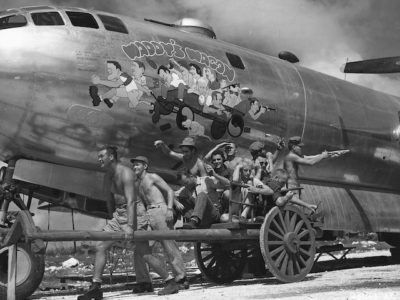The practice is as old as aviation itself: the personalization of aircraft by painting a name or unique design on an aircraft’s fuselage. Since these depictions often appeared on the front of the aircraft, they became known as “nose art,” and to a certain extent, the practice continues to this day.
The origin seems to center around WW l. America’s top ace, Medal of Honor recipient Eddie Rickenbacker, flew into battle with the 94th Aero Squadron’s famed “Hat in The Ring” painted on the side of his SPAD XIII biplane.
Count Francesco Baracca, Italy’s top ace during WW I, had a black horse, bucking up on its hind legs, painted on his plane. Automaker Enzo Ferrari adopted that image as the symbol of his company, which today is recognized around the world.
Between the wars, the practice carried over into civilian aviation. Most notably, when Charles Lindbergh became the first person to fly solo across the Atlantic Ocean, he did so in a plane with “Spirit of St. Louis” painted on its nose.
However, it was during the Second World War that this practice took off. Painting everything from your best girl’s name to popular cartoon characters to risqué depictions of fantasy females became the norm rather than the exception. So much so that certain commands censored the nose art it would allow on their aircraft.
Often, highly skilled artists created flying works of art utilizing the aircraft’s skin as their canvas. There was heated competition between pilots to have the best and most unique nose art. Artists who could create these masterpieces became highly sought after and valued. Many planes received a great deal of publicity and became icons with America’s wartime public. As a morale booster for the crews who flew the planes into combat and for the folks at home who followed their progress, nose art became de rigueur with most aviation units on both sides of the lines.
While the practice reached its zenith during WW ll, it witnessed a resurgence during the Korean War. During the Viet Nam War, many a helicopter was adorned with nose art. A favorite was Charles M. Schulz’s cartoon character Snoopy, complete with goggles and aviator’s scarf, as he piloted his doghouse into the skies. While generally unauthorized today, occasionally nose art can still be seen on military aircraft.



0 comments on “Check out these flyboys with a nose for art”